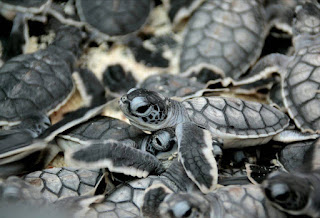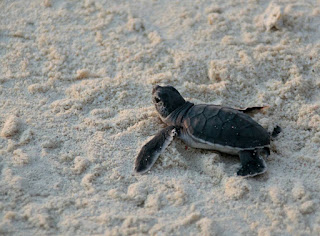 |
| Photo by Lizz Fitt |
Once reaching the water their weight will reduce and the
physical struggles of a creature made for the sea moving on land will
diminish, but the danger of the ocean and its predators increases– so much so that only 1
in 1000 hatchling turtles will reach sexual maturity. Just offshore ocean
predators wait, even from the beach a barracuda is seen lurking in the
shallows.
 |
| Photo by Lizz Fitt |
The first task of a hatchling sea turtle is to find a raft
of seaweed, which will provide a degree of shelter from harsh ocean conditions,
and under which it can hide from predators. This refuge-giving raft also
provides the fresh hatchlings a chance to rest and makes it easier for the
little turtle to reach the oxygen it needs above the surface of the ocean. If
it finds enough cover and has enough luck, baby sea turtles will float with the
current in their seaweed raft feeding on smaller crustaceans and fish until the
age of 5 or 6 and it is big enough to handle the open ocean. However, even at
this adolescent stage the turtles are still small, roughly the size of a dinner
plate, and subject to much predation. But if they survive the odds, Sea Turtles
instinctively return to the beach on which they hatched when they reach sexual
maturity at 35.
 |
| Photo by Lizz Fitt |
Female turtles lay anywhere between roughly 250 - 700 eggs
each of their season, meaning they will produce roughly 4 – 8 offspring
throughout their life if they die by old age. For Pom Pom, with our many
nesting turtles, and the many nests they lay, we estimate about 2000 eggs are laid
each season – and we hope two more turtles from this seasons nesting will return
to lay and fertilize eggs and make more hatchlings in 35 years.
We cannot protect out hatchlings from the perils of the
ocean, but we can protect the eggs from the danger of poaching, and offer the
hatchlings a chance to test their luck and survival in the ocean.
--------------------------------------------------------------
If you want to help with any marine conservation activity, please
check our website http://tracc.org or e-mail info@tracc-borneo.org
For more updates on TRACC check out our Facebook, Twitter or Google +
If you want to help with any marine conservation activity, please
check our website http://tracc.org or e-mail info@tracc-borneo.org
For more updates on TRACC check out our Facebook, Twitter or Google +
Reef conservation would not be possible without generous financial support from
GEF /SGP for Malaysia who are helping our community activities and coralreefcare.com who generously provided materials to build the new reefs.
If visits to Tracc are not possible then please help with financial support and follow their projects on Facebook.
